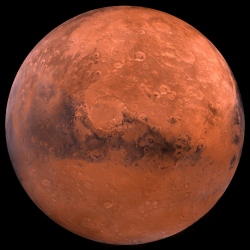
While Elon Musk focuses on mass-transport solutions to bus people to the surface of Mars, Lockheed Martin is working on an earlier stage mission with the objective of allowing real-time scientific research on the Martian surface and helping to identify an ideal landing spot for when humans touch down some time in the 2030s.
In a technology roadmap layout, the aerospace giant emphasizes how a manned, orbital Mars space station is possible as soon as 2028 using existing technology, by accelerating some flight test objectives.
In 2021, the team plans to start putting components of the Mars Base Camp space station into orbit between the Earth and the Moon, using the biggest rocket ever built. The gigantic, 322-foot-high Space Launch System provides super heavy lift launch capabilities to get the pieces and supplies off the ground.
Some will be assembled in orbit, others will rendezvous with the rest once they make it to Mars, and they’ll make the trip across using solar electric propulsion. This uses solar energy to ionize a xenon propulsion gas into an exhaust plume of plasma, extracting about 10 times as much thrust as a conventional chemical rocket for the same amount of fuel, and providing a steady, constant push throughout the journey.
By 2028, all should be ready for the manned missions. Six astronauts will hop into the Orion spacecraft, attached to Space Launch System rockets, and begin the trek across. One of these craft will go straight to the space station, the other will explore Deimos and Phobos, the two moons of Mars, before docking at Mars Base Camp.
Once the space station is fully assembled and manned, the crew will begin real-time joystick-style operation of research assets on the Martian surface, analysis of rocks and soil, and the search for an ideal landing place when the first manned surface mission is attempted in the 2030s.
Lockheed Martin is designing the space station differently to the ISS, as it will spend a lot of its time unmanned and needs to run efficiently and reliably as an autonomous system. Thus, it will use a lot of the Orion capsule’s capabilities as key life support, navigation, communications and radiation protection features.
Orion is built to support missions up to 1000 days, where the Mars Base Camp space station only needs to accommodate crew for 30 to 60 days. Once the mission is complete, the Orion capsules will take the astronauts back to Earth – it’s built to keep them safe during re-entry into our atmosphere.
It’s been decades since humanity had so much to look forward to in manned space flight. The race to Mars is a welcome injection of awe and possibility into our terrestrial lives.
